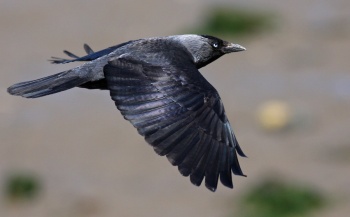(Flight photo. Subspecies and misc information added. References) |
(corrected distribution, added some info) |
||
| Line 2: | Line 2: | ||
;[[:Category:Corvus|Corvus]] monedula | ;[[:Category:Corvus|Corvus]] monedula | ||
==Identification== | ==Identification== | ||
| − | *Black | + | *Black plumage |
*Blue-black metallic sheen on back and shoulders | *Blue-black metallic sheen on back and shoulders | ||
*Grey nape and ear patches | *Grey nape and ear patches | ||
*Pale grey iris | *Pale grey iris | ||
*Short, pointed bill | *Short, pointed bill | ||
| + | *''Soemmerringii'' with a distinctive pale collar | ||
| + | Sexes similar. Juveniles have a dark iris and a softer, tinged-brownish plumage without gloss. | ||
| + | [[Image:IMG 4697 1.jpg|thumb|350px|right|Photo by {{user|Mahsleb|Mahsleb}}<br />Mistley, [[Essex]], May 2009]] | ||
| + | ====Similar species==== | ||
| + | Immature [[Daurian Jackdaw]]s look similar to this species. | ||
==Distribution== | ==Distribution== | ||
| − | [[ | + | Found in most of [[Europe]], patchily in northern [[Africa]], the [[Middle East]] and western and central [[Asia]].<br /> |
| − | [[ | + | Accidental vagrant to northeastern [[United States]] and [[Canada]]. <br /> |
| − | + | Abundant in most of its range but populations have decreased in most western European countries in the past. | |
| − | Accidental vagrant to northeastern [[United States]] and [[Canada]]. | ||
==Taxonomy== | ==Taxonomy== | ||
====Subspecies<sup>[[#References|[1]]]</sup>==== | ====Subspecies<sup>[[#References|[1]]]</sup>==== | ||
| Line 30: | Line 34: | ||
The diet includes insects, amphibians, rodents, seeds, fruits, berries, reptiles, eggs and young birds. | The diet includes insects, amphibians, rodents, seeds, fruits, berries, reptiles, eggs and young birds. | ||
====Breeding==== | ====Breeding==== | ||
| − | + | Breeding season starts in late April. Pairs stay together for several years. Usually several pairs are nesting in close proximity on rooftop chimneys, in caves and quarries. The nests are untidy stick structures. They will use long nest boxes. Lays 3 -8 (average 4) eggs. | |
====Vocalisation==== | ====Vocalisation==== | ||
'''Call''': a ringing ''kyow'', also ''chiak''. | '''Call''': a ringing ''kyow'', also ''chiak''. | ||
| Line 36: | Line 40: | ||
''[[Media:Corvus monedula (song).mp3|Listen in an external program]]'' | ''[[Media:Corvus monedula (song).mp3|Listen in an external program]]'' | ||
==References== | ==References== | ||
| − | #{{Ref- | + | #{{Ref-Clements6thDec08}}#{{Ref-HBWVol14}}#BF Member observations |
#Whatbird | #Whatbird | ||
{{ref}} | {{ref}} | ||
Revision as of 17:45, 19 March 2010
- Corvus monedula
Identification
- Black plumage
- Blue-black metallic sheen on back and shoulders
- Grey nape and ear patches
- Pale grey iris
- Short, pointed bill
- Soemmerringii with a distinctive pale collar
Sexes similar. Juveniles have a dark iris and a softer, tinged-brownish plumage without gloss.
Similar species
Immature Daurian Jackdaws look similar to this species.
Distribution
Found in most of Europe, patchily in northern Africa, the Middle East and western and central Asia.
Accidental vagrant to northeastern United States and Canada.
Abundant in most of its range but populations have decreased in most western European countries in the past.
Taxonomy
Subspecies[1]
This is a polytypic species, consisting of four subspecies:
- C. m. monedula:
- Scandinavia; occasionally winters to England and France
- C. m. spermologus:
- Western and central Europe; winters to the Canary Islands and Corsica
- C. m. soemmerringii:
- C. m. cirtensis:
Habitat
Breeds on cliffs, quarries, castles and cathedrals, also parks with open woodlands. Winters in open farmland.
Behaviour
They can form large winter roosts, often along with Rooks.
Diet
The diet includes insects, amphibians, rodents, seeds, fruits, berries, reptiles, eggs and young birds.
Breeding
Breeding season starts in late April. Pairs stay together for several years. Usually several pairs are nesting in close proximity on rooftop chimneys, in caves and quarries. The nests are untidy stick structures. They will use long nest boxes. Lays 3 -8 (average 4) eggs.
Vocalisation
Call: a ringing kyow, also chiak.
<flashmp3>Corvus monedula (song).mp3</flashmp3>
Listen in an external program
References
- Clements, JF. 2008. The Clements Checklist of Birds of the World. 6th ed., with updates to December 2008. Ithaca: Cornell Univ. Press. ISBN 978-0801445019.
- Del Hoyo, J, A Elliott, and D Christie, eds. 2009. Handbook of the Birds of the World. Volume 14: Bush-shrikes to Old World Sparrows. Barcelona: Lynx Edicions. ISBN 978-8496553507
- BF Member observations
- Whatbird
Recommended Citation
- BirdForum Opus contributors. (2024) Eurasian Jackdaw. In: BirdForum, the forum for wild birds and birding. Retrieved 17 May 2024 from https://www.birdforum.net/opus/Eurasian_Jackdaw
External Links





